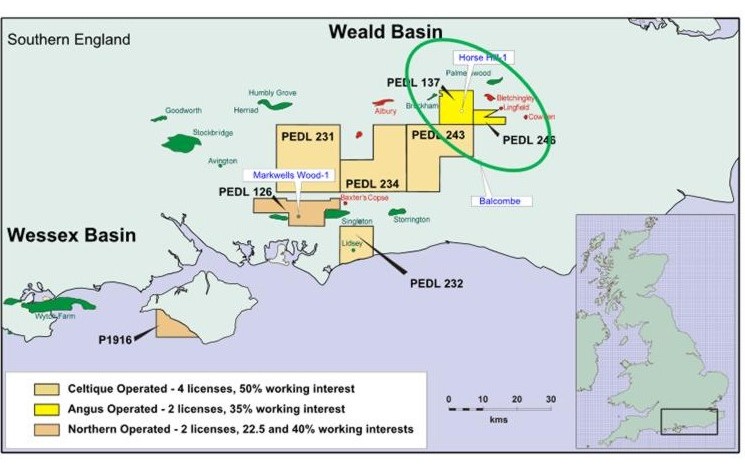Horse Hill oil strike could be “major discovery” for Solo Oil and UKOG

By Amy McLellan
Shares in AIM-quoted UK Oil & Gas Investments gushed more than 83 per cent higher on Thursday morning before settling down 25 per cent higher at 0.73p after it was revealed that its Horse Hill discovery in the Weald Basin of southern England was much bigger than expected. Nutech, a leading petrophysical consultancy, reckons Horse Hill-1 carries total oil-in-place of 158 million barrels per square mile – and that’s not counting the Upper Portland Sandstone oil discovery.
Nutech’s report says the OIP estimate lies within a 653 feet aggregate net pay section, primarily within three argillaceous limestones and interbedded mudstones of the Kimmeridge, and the mudstones of the Oxford and Lias sections. About 72 per cent of the OIP, or 114 million barrels, lies within the Upper Jurassic Kimmeridge interbedded limestone and mudstone sequence. Final assessments of the Upper Portland Sandstone and the Oxford and Lias sections are in progress, with further results expected shortly.
The discovery, just 3 km from Gatwick airport, is operated by Horse Hill Developments Ltd (HHDL), a special purpose company which owns a 65 per cent participating interest alongside Magellan Petroleum Corp with a 35 per cent interest. UKOG has a 30 per cent direct interest in HHDL and a 1.32 per cent interest in HHDL via its 6 per cent interest in Angus Energy Limited. Fellow AIM company Solo Oil has a 10 per cent stake in HHDL.
UKOG has a 20.36 per cent stake in the Horse Hill licences in the Weald Basin, which stretch for 55 square miles. In order to establish estimates of total OIP within the licence area, there’s ongoing analysis by Nutech, UKOG and Solo Oil, which has a six per cent stake in the discovery. Shares in Solo surged by as much as 25 per cent in morning trading.
Stephen Sanderson, UKOG’s CEO, said this could be a “possible world class potential resource in what is interpreted to be a new Upper Jurassic “hybrid play”, with the licences within the “likely sweet spot” with the “potential for significant daily oil production”.
“Drilling the deepest well in the basin in 30 years, together with the ability to use concepts, techniques and technology unavailable in the 1980s, has provided new cutting-edge data and interpretations to comprehensively change the understanding of the area’s potential oil resources,” said Sanderson
He drew comparisons between the Horse Hill Upper Jurassic rock sequence with known oil productive hybrid reservoir sections of the Bakken, the Wolfcamp, Bone Springs, Clearfork, Spraberry, and Dean Formations in the US Permian Basin and the Bazhenov Formation of West Siberia. He pointed out that the US analogues have estimated recovery factors of between 3 per cent and 15 per cent of oil in place.
Importantly, UKOG believes that high pay thickness and a naturally fractured limestone reservoir means the reservoirs could be successfully produced using conventional horizontal drilling and completion techniques – in other words, no fracking.
Solo’s chairman Neil Ritson said the find “may have very major significance for the Basin and for Solo’s interest”.
This is still very early days – there needs to be further appraisal drilling, testing and analysis before judgements can be made on the productive potential and commerciality of the find – but it’s certainly a welcome shot in the arm for the fortunes of the small companies behind HHDL.
Comments (0)